Revenge is a Dish Best Served Cold
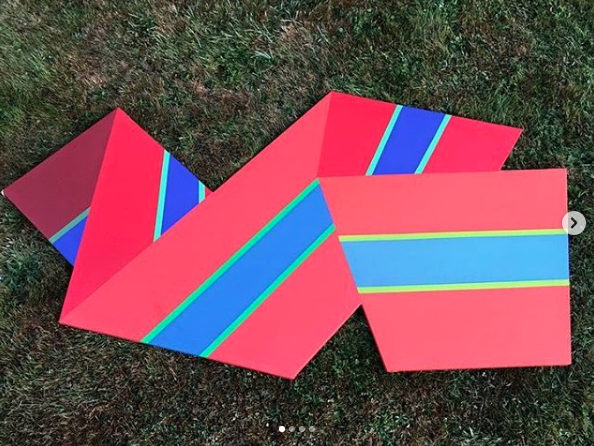
Allow me to set the stage for those of you who have yet to make the mecca to Brimfield. Picture thousands of antique dealers set up in grassy / muddy / dusty fields, under tents (some not) with various wares on tables and on the ground. Fresh finds being pulled from inside trucks and from under tables, shoppers are chomping at the bit to find that needle in the haystack. 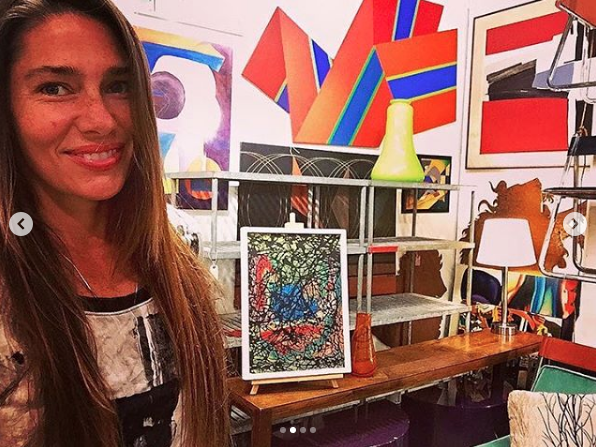
I was more grounded that day and just wanted to buy something good. When I saw this hard edge, shaped canvas, abstract painting I knew that I had found it. Fresh from a NY apartment (yes, I live in NYC and bought this in Massachusetts from a NY dealer and then had to bring it back to NYC) I grabbed it as soon as it came off the truck. After I paid, I saw that it was signed. Illegibly, of course, because artists have horrible penmanship. I brought it back to my space and propped it up against my SUV. 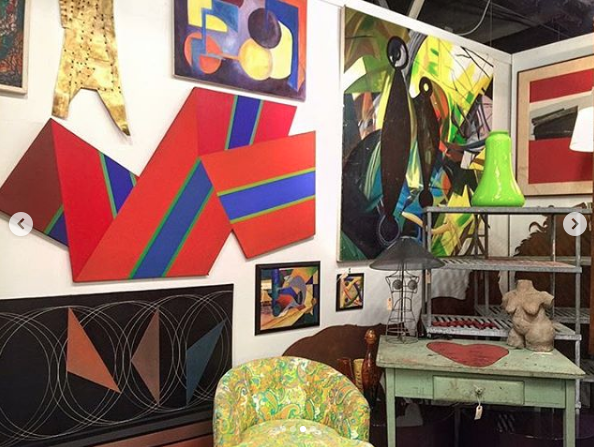
Then a dealer came by and asked a price. I told him that I would be bringing back to NYC and then to High Point, NC where I used to set up at a big show. Insert sour puss face. The dealer then proceeded to tell me how he knew the artist but wouldn’t tell me. Then he had the audacity to say that I would never be able to figure out the name so I might as well just take his offer of $500 and be happy. Excuse me? Oh yeah, it was on. I was prepared to go all the way with this painting now and if he thought he’d ever wind up with it he was sorely mistaken. 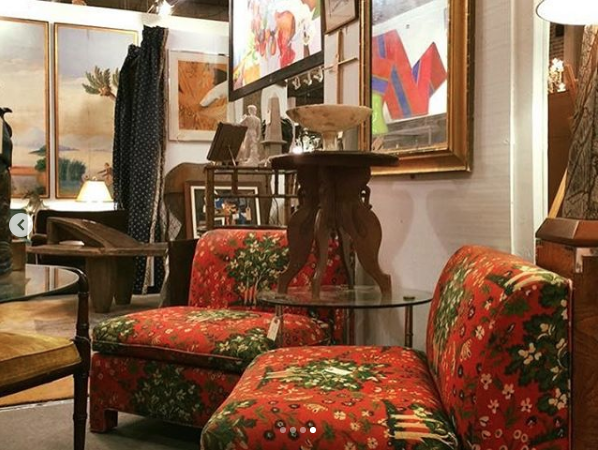
In a short 30 minutes I had deciphered the signature and placed the work in the back of my SUV. $500 my foot. One month later I was in High Point set up and ready to sell. An interior designer came through and immediately bought the painting after I told her the whole story. Provenance with an attitude. And the dealer? I made sure to tell him what I sold it for the next time I saw him. ;-) hkv
Hidden Messages
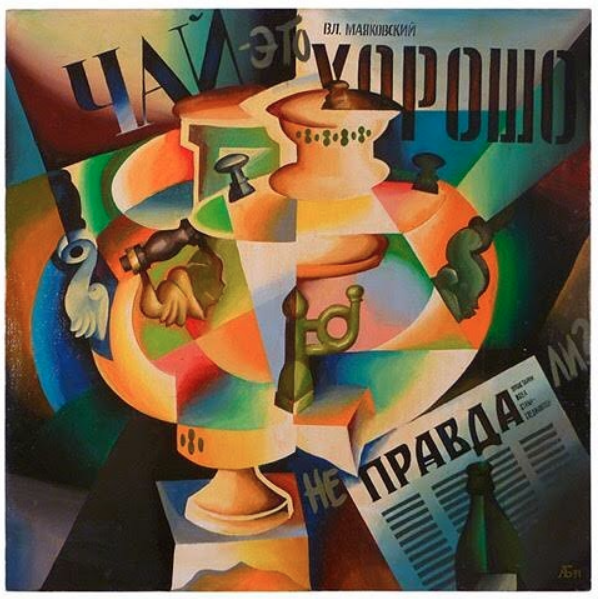
Why, you ask. Because I always bought something great from him and for my daughters it was because he always had Oreos. I call that a win-win. This painting was still unsold after the morning rush of dealers. You see at this time my family and I were living in Connecticut and I would often bring my girls with me to the market. Just not at 3am. More like 9am. Each snug in their half of the double stroller, we wound our way through the Garage looking for treasure. And Oreos. As soon as I saw this painting I knew I needed it. By now you know I love a mystery and this one posed a great sleuthing opportunity. Getting home I quickly went to my computer to begin the task of translating the work. It referred to a famous Russian Soviet poet, Vladimir Mayakovsky. Mr. Mayakovsky was a stand out figure in the Russian Futurist movement as well as supporter and critic of the Soviet State in the early 20th C. Quite a dangerous tightrope to walk if you ask me. The word on the top left is Chai followed by the word for This. Then at the top you’ll see Vladimir Mayakovsky and under it the word for All Right or Nice! Scrolling down you’ll see the word Pravda, which as you know is both the word for truth and the name of the official newspaper of the Communist Party of the Soviet Union. What you may not know is that by adding those letters before and after, the artist changed the meaning of Pravda from truth to untruth. While Mayakovsky died by his own hand some 61 years before this painting was created, this artist aptly told his story through a painting of a deconstructed samovar. With each piece that I buy I am presented with an opportunity to learn, but sometimes it’s the memories of the experience that stay with me. Because every time I think of this painting, I think of my two little girls eating Oreos. ;-) hkv
Extra Information:
I always seem to be getting myself into situations that need an incredible amount of translation. Whether it's hopping on a plane to shop for antiques in Brazil (no, I didn't speak much Portuguese) or buying unsigned paintings (something I've gotten quite good at, if one can be 'good' at such things) or buying paintings from other parts of the world where English really isn't the norm. And that's where I was a few years ago. Translating a Russian painting. Wait a minute, did I say translating a painting? Yes. This particular work by contemporary Russian artist Anatoly Belkin is full of symbolism and words. In Cyrillic.
Looking at the painting one late morning at the New York City flea market (I couldn't go at my usual early hour), I knew that it was something special. I spoke with my friend about the painting and as antique dealers are apt to do, he tried to talk me out of buying it. "Heather, everyone has seen this already", he said. I bought it anyway. The business is a funny one and if a dealer thinks that all the 'right' people have already seen something and passed on it they sometimes lose a little faith in it. It only makes sense because we as dealers are buying on our own taste. If those choices are not validated by a sale, we begin to think that we made a mistake. It's just how the business works. But, back to the painting...
I asked my friend what it was all about and who the artist was. His only information was that it was a painting of a samovar and was full of Russian words. There are plenty of dealers at the flea market who speak Russian, but I chose to try my hand at translation. First though, I had to figure out who actually painted the painting. Signed with a monogram and dated 91, I couldn't wait to get home and begin my search. Trying a few different online sites, I finally found the one that gave me my answer (for just $25 per year). The monogram Ab is for Anatoly Belkin. Turns out he's alive and well and painting in Russia. He was born in 1953, went to art school in Russia and works in St. Petersburg. Great. Now, what does the painting say? Looks like another search is in order...
Found another great site, this one to translate the Cyrillic alphabet. Working the letters out and then searching again gave me my answers. Sort of. The painting says a lot about tea. And Soviet poets. And truth. Or actually un-truth. So, here goes. At the very top is the name of a famous Soviet poet Vladimir Mayakovsky. Mr. Mayakovsky was born in 1893 and lived a life that he cut short, committing suicide in 1930. Those years in between were filled with protests, jail terms, love affairs, poems, stage plays, friendships and so much more. He was close friends with David Burliuk and the two would explore Futurism in it's many veins. They were known to stand on street corners reciting poetry and throwing tea at their audiences. This was to annoy the bourgeois art establishment. From what I read, they were quite successful. In another refernce to tea, Mr. Mayakovsky is know to have said about Anton Chekhov, "Language is as precise as 'hello' and as simple as 'give me a glass of tea". There is also a famous poem by Mayakovsky where he commands the sun to stay with him and have a tea.
And what is all this talk about tea? Well, the samovar is the main focus of the painting. At the top left, there is the simple statement, "This is tea". And below that one reads the word for 'very good". It was all starting to come together. Sort of. And now for the truth, or rather un-truth. The newspaper Pravda features quite prominently along with the slogan, Workers of the World Unite! But what are the letters before and after Pravda? Well, the addition of those letters turn Pravda (truth) into un-truth or falsity.
So what does this all mean? Not sure yet. Literal translations of art are pretty superficial. The truer deeper meaning is in the understanding. And for that understanding, I spent some more time with the painting and my computer. Searching for the answers and the understanding.
Is That A Marker In Your Pocket

I had been regaling my friends and colleagues at the flea market with stories of the previous night’s antics at the club where I worked. Tales of drunk girls puking on their friends were always a big hit. Me with my coffee and Robert with his tall boy had broken away from the group and were strolling among the tables in the pay lot laughing and giggling and calling each other ‘girlfriend’. 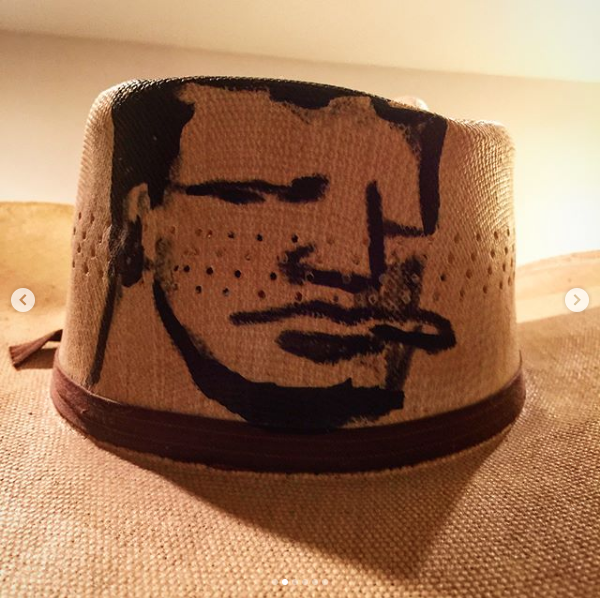
Before I knew it, Robert had grabbed this hat off one of the tables and was drawing his famous Brute right on it. His Sharpie was always in the back pocket of his jeans - ready. After a quick signature and date, he plunked the hat down on my head and said, ‘Gimme 20 bucks girlfriend’. Obviously I obliged and began to walk away. You see, Robert had already made a bee line for another table and was purchasing what I can only assume was an incredible score with that twenty dollar bill. 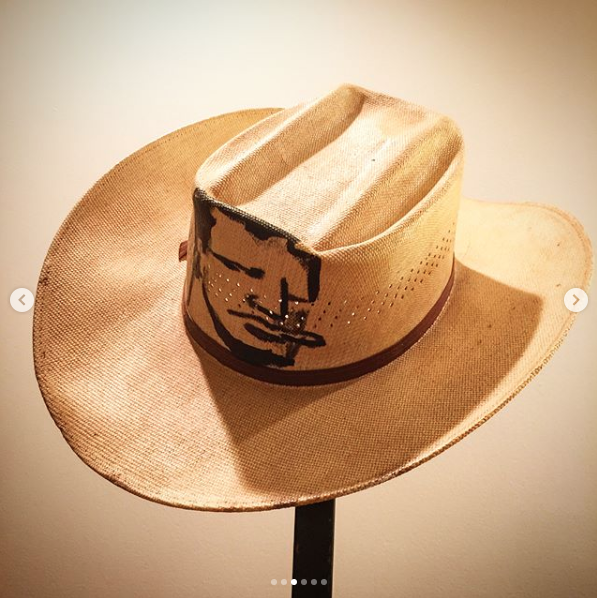
To say that Robert had a great eye, would be a massive understatement. He was a wealth of knowledge and a true ‘picker extraordinaire’. My happiness at having had this moment with someone who I truly admired was broken when the dealer who had the hat for sale yelled after me, ‘Hey, GIRLFRIEND, you can give me twenty bucks too’. 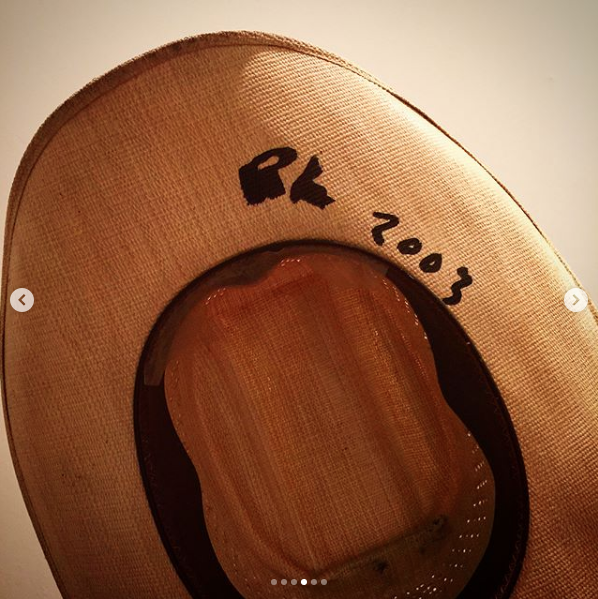
Again I obliged and took great pleasure in my new found work of art. It was the best forty dollars I spent that morning. The frames I had purchased were all sold and forgotten within a matter of days. But not this hat. 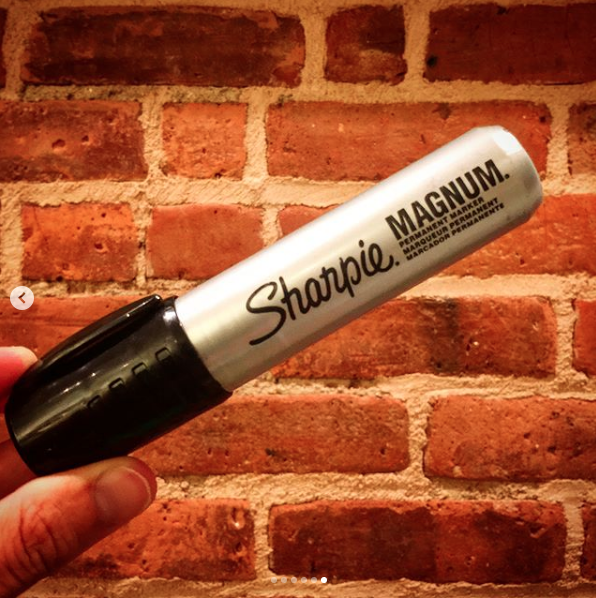
Fifteen years later I still have it. And it still brings a smile to my face to remember that morning. I hope it brings a smile to your face as well, now that you know the story. ;-) hkv
Diamonds in the Rough
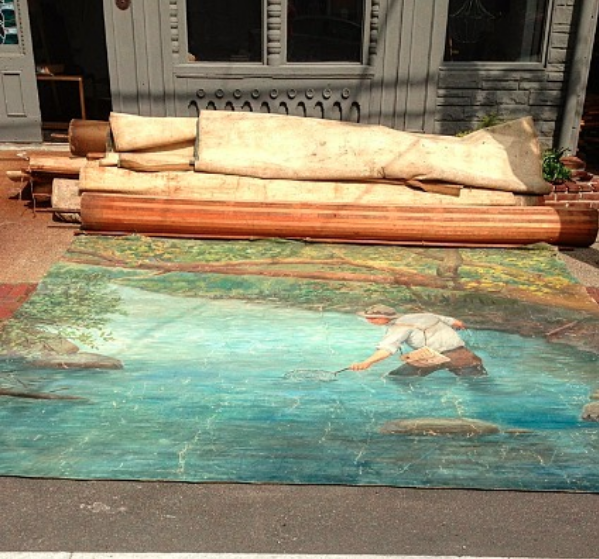
Such was the case about five years ago or so when I came across fourteen incredible hand painted murals on canvas dating to the 1930s to 1950s in a place where I was buying a whole other category. As soon as I set foot upon them, yes I mean set foot rather than set eyes, I was immediately ready to find something amazing. With the light of my cell phone I realized that each mural was rolled around a lath cylinder spanning over ten feet in width. The length of each #mural was a mystery at this time because the clock was ticking and I had to race to get all of my soon to be purchases out of the building. It wasn't until the next sunny day that I was able to unroll each of the murals across the sidewalk and into the street to see exactly what I had just purchased. In typical fashion, they were a mystery to me at the time of purchase. To this day, even though I sold them all to one person shortly after buying them, their provenance remains a mystery. Each of the murals depicts outdoor scenery with lions, fly fishing and hunting and dogs being the dominant scenes. The murals were all so well painted and in good shape considering the conditions they were in (let's just say less than ideal) that I was immediately invested in their research. But it didn't get far as the soon-to-be buyer spotted them in what was the window of my storefront in Philadelphia. We struck a deal and I rented another truck to deliver them. Today you can find these murals in Philly and New York City and Milan so keep an eye out for them. And always be ready to find something amazing! ;-) hkv
Don't Let Them Tame You
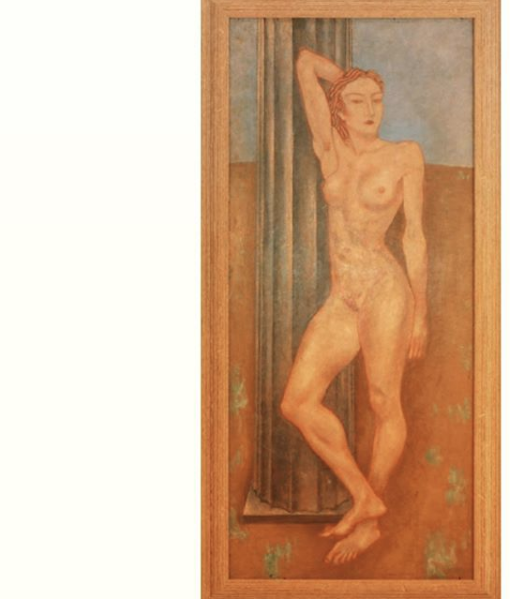
We would need to ask American artist Maxwell Simpson for he was the one who painted this posthumous portrait of the dancer. I bought this piece many years ago at a Pier Show in New York City from another dealer. The work caught my eye just as it was being unloaded from the dealer's truck. Believing that the early bird gets the worm I jumped on the chance to buy the portrait. Even before I knew the artist. Even before I knew the subject. Simply because it struck a chord. I was moved by the sense of confidence and vulnerability. A portrait is a personal story. Like a biography it is a life told through someone else's eyes. The artist portrayed Isadora Duncan leaning against a fluted column as perhaps a nod to her often classically Greek inspired robes, tunics and dresses that exposed her arms and legs during her performances, something that was considered taboo among many at the time. Her body is taught, yet relaxed. She was no stranger to nudity. Maxwell Simpson told her story through the painting. She told her story through her dance. But when this story reaches deep into the soul, a connection is made. These connections are the reason for the antiques and art business. Folks see the passion in both the subject and the medium. Folks want to be part of the history of a work. You were wild once don't let them tame you. So don't be afraid to be bold, to buy with your eye as you will benefit from the experience. Each piece that I buy is a new opportunity to learn. I was introduced to the work of Maxwell Simpson and to the history of Isadora Duncan. I was shown again how chances taken are always rewarded. Through knowledge gained. Through experiences shared. Through history learned and continued. ;-) hkv
Martha, Martha, Martha

I can still picture it. A super wide, stepped molding with a gesso finish. This style remains to this day my all time favorite. Matter of fact I bought three of those profiles yesterday but that's another story. So when the dealer told me how much for the painting, I knew I could pop off the frame and sell it at a profit. So the painting would just be a little extra. Turned out to be a lot extra. This portrait of dancer Martha Graham was painted by American artist Paul Meltsner. Back then I didn't know Meltsner's work nor did I have a means to research anything before I bought it. It was strictly buy with your eye as my mantra. And so I sold the frame to one of my off Madison Avenue gallery clients and the painting was in my West Village apartment. Till one day when I thought I'd better look up the signature. Well you could say I was surprised. I immediately sent an email to Sothebys American paintings department and they put me in touch with the Arcade. How many of you remember Sotheby's Arcade? It was a great auction division for good paintings. And this was a good painting. Gotta say that the Arcade was my go to sales venue for this and more than a few other unintentional painting purchases. Nowadays that middle market has all but disappeared. But let us not lament the past. Simply enjoy the lessons it taught us. I learned a good one that day. ;-) hkv
Never Sell and Tell

This is the behind the scenes shot of an everyday shopping trip for an art dealer. Oh, and my kids were in the car too. You see, we had taken a trip down the shore for the weekend and of course I had to squeeze in some antique shopping. After going through a few stores, I came across an out of the way shop that didn't get much traffic because the owner of said shop was notoriously cranky. Well, I thought, time to put my years of waitressing skills to work and kill them with kindness. It worked and I was let in to shop. After putting together a pile of odds and ends, the owner asked if I wanted to look in the warehouse. Um yes please. And it was there that I saw it. Tucked up in the rafters of the roof. A gorgeous and huge Stanford White design antique frame. I grabbed a ladder and climbed right up into the roof to haul it down. It had been refinished at some point, but it still retained its gorgeous basket weave and eared corner design. The molding width was crazy wide. It was a thing of beauty. You know why I love frames so much? It's because they are at once beautiful and useful. They are architectural and artistic. They are furniture and art. I couldn't pay for it fast enough. After a quick rearrange of the day's pickin' I headed back to the hotel with a huge smile. You know, I've been back to that same shop a bunch more times hoping that lightning strikes twice but it hasn't happened. Yet. Where is the shop, you ask? I never sell and tell. ;-) hkv
Holding Out for a Hero
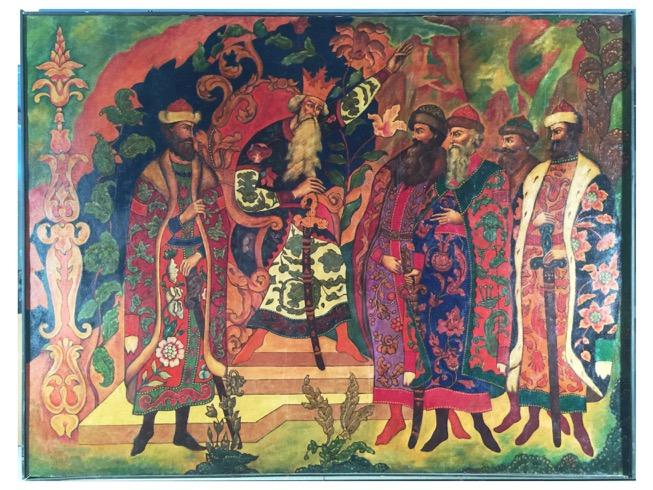
Upon entering the battle his weakened forces suffered many losses at the hands of the Mongols and Prince Igor was captured. After some time his captors organized his escape and Prince Igor returned home. Defeated. But with a second chance... The chance to return home. This painting is one of three which tell the Russian epic poem from the 12th Century of an unlikely hero and his faults, his missteps and his return. 
These oil paintings have also made a return. A return to the family of the artist - they have come full circle. Through diligence and research and sheer good luck, today I made a delivery and brought the art home. I had bought these paintings years ago. They had made their journey and I had come across them. Rolled up. 
Told that all the other dealers had passed on them so they must be of little value. Value. What is valuable? History. Legacy. Stories passed down from one generation to the next through art. I think of myself as a vehicle taking art from the past and bringing it to the future. Generations to come will know the art of their ancestors. I am honored to be part of the history of these paintings and their legacy. ;-) hkv
Extra Information:
Eugene Andrew Agafonoff (Evgeny Andreevich Agafonov) was a Ukrainian painter, graphic artist and scene-designer who was born in 1879. He was born to a family of merchants. He got his first art education in St. Petersburg Academy of Arts in 1899–1907. He studied under the guidance of P. Kovalevsky and F. A. Roubaud. In 1910 Agafonov was awarded gold medal for the painting Draymen at the regional South Russia exhibition in Ekaterinoslav. In 1905–1907 during the Revolution, Agafonov illustrated Kharkov satirical magazines Shtyk (“Bayonet”), Mech (“Sword”), Zloy Dukh (“Malignant Demon”) and others. In March 1906 Agafonov together with A. N. Grot, V. D. and D. D. Burlyuk participated in the 7th exhibition of the Cirlce of Kharkov artists (1900–1908). Since 1908 he exhibited his works at the exhibitions of the Association of Kharkov artists, at the exhibition of the group Zveno (“Link”) in Kiev (1908), in Rostov-on-Don and Kursk. In 1909 Agafonov founded the experimental theatre, Blue Eye, in Kharkov on the basis of the avant-garde studio Blue Lily. He designed a lot of performances for this theatre, including The Stranger by A. Blok. The theatre worked only two seasons and was closed in February 1911. Later Agafonov left the Association of Kharkov artists and organized an avant-garde group Koltso (“The Ring”, 1911–1914). Members of the group were A. N. Grot, A. M. Zagonov, N. R. Savvin, M. S. Fedorov, E. A. Shteinberg and others. In 1913 Agafonov joined the group Bubnovy Valet (“Jack of Diamonds”), took part in the exhibitions of the group in St. Petersburg. Agafonov participated in the First World War; in 1918 he returned to Kharkov. In the same year he designed covers of the Theatre Magazine . Agafonov joined the group Khudozhestvenny Tsekh (“The Art Guild”); in 1918–1919 he together with M. A. Voloshin, Mane-Katz, and E. A. Shteinberg took part in the exhibitions of the group. In 1919 Agafonov lectured as an art critic in the studio of painting and drawing under the ProletCult (Proletarian Culture). He also exhibited his works at the First exhibition of the Art department of Kharkov Soviet of worker’s deputies. Evgeny Agafonov painted a lot of portraits including Lieutenant P. P. Schmidt’s lawyer, A. Alekseev (1906) and portrait of the actress V. F. Komissarzhevskaya (1908). In his paintings Agafonov often used Ukraine national motifs. He also painted landscapes, drew sketches and did drawings. In early 1920s Agafonov immigrated to the USA. He was engaged in easel painting, graphic art and advertising. He exhibited his works at the exhibitions of the Society of Independent Artists (1929); in the French gallery in New York (1931); in the Greenwich public library (1939); and in Derby, Connecticut (1943). Personal exhibitions of the artist were held in the Cas-Delbaut gallery in New York (1931). Works by Evgeny Agafonov, which the artist left in Kharkov, were kept in Kharkov Art Museum. During the Great Patriotic War, the greater part of his works was lost. Only several drawings and theatre designs remained in Kharkov Art Museum." Mr. Agafonov died in 1955. *Info from Art Investment Russia
Is It Jean or Hans

That's the life I've carved out as an antique dealer and art dealer. Am I big time? Hardly. I'm a hustler and a picker. It's the deal that I love. The energy in the hunt. You could say the thrill of the hunt. But for me it's even more. It's the chance to hit it big. To win the lottery if you will. And it's not just the money (don't get me wrong, the money will be great) but it's also the feeling that something important in the eyes of the art world is now in my possession. And here we come to this carved stone abstract sculpture that I bought under the El in Philly five years ago or so. To me it's Jean Arp / Hans Arp all day. Think dada, surrealism, abstraction, bio-morphic sculpture guided by nature. Human Concretion Maybe. Just maybe. Or it's a cool sculpture that I bought one blisteringly hot summer day in Philadelphia when the mercury had hit 95 and the humidity had hit 100. But hey, that's summer Philly style. So maybe the heat got to me. Or maybe I have a masterpiece in my living room. Time will tell. For now it remains $80 bucks well spent. I guess I'd better send out that email to the Fondation Arp. ;-) hkv
The Brute

He was buying important mid century furniture before it was important ... He was a staple at the Chelsea flea market ... There are stories about Robert ... For now, let's talk about the one that I know best ... It was an unusually cold day in early spring 2002. I was making the rounds at the flea market. Robert was one the person who I noticed first. You couldn't miss him. Booming voice. Calling everyone 'girlfriend'. Standing at the back of his pick up with some amazing finds that all the other dealers would fight over. It was as if he were holding court and teaching school at the same time. This morning I had brought with me a chair I found on the street ... When I asked him if he'd paint my chair he quickly agreed. He did what any dealer would do and examined the chair. Joking, he made a few references to famous designers but I said that I didn't care who made the chair I wanted him to paint it. The chair disappeared into the back of his pick up truck and we went about our shopping in the early hours. Me with my coffee and Robert with his felt tip marker and eye for detail. I felt like a superstar when I would hang out with him ... So, the day finally came. Robert walked up to me and said that he had brought my chair ... The other dealers seemed envious and made the immediate assumption that I would try and flip it right then and there ... I placed it under a vendor's table and kept it out of sight until I was ready to head home ... It became my desk chair ... I felt as though I had elevated my business just with this chair alone ... He was a truly nice person ... I will always cherish the chair he made for me and remember fondly the fun times. ;-) hkv
Keeping Up The Pace
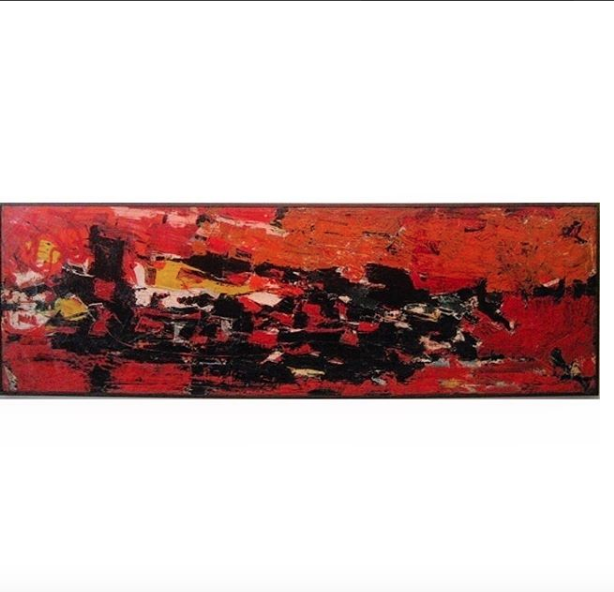
He had served his country for four years in World War II and then enrolled in art school. It was in the art school that he met Milton Avery. Years later in New York Pace would reconnect with Avery as well as study under Hans Hofmann and become friends with Willem de Kooning, Franz Kline and Jackson Pollock. You see, the 1950's in New York City was a hot bed for the burgeoning school of abstract expressionism. Mr. Pace was in the thick of it. He painted this incredible oil on canvas abstract painting in 1952. And I bought this painting some fifty five years later also in New York City. I was making the rounds to some of my favorite shopping places when I turned onto 11th Street in Greenwich Village. Walking up to the shop, the door was being propped open by something. That something turned out to be this painting. My eyes popped and and jaw dropped. I recognized the name, but I didn't buy it for that (yeah, the one time something I buy is actually signed). I bought it because it spoke to me. And isn't that why we buy art. Why we have to save art. Why we are art dealers. We are constantly seeing things in and out of context. Surely using a master work by a top abstract expressionist artist as a door stop does not present the proper context. But it is up to us to see in it the potential. And then to be the vehicle to carry the work forward. This painting is now in a private collection and I'm happy to have been part of its journey. ;-) hkv
Extra Information:
Have you ever heard that? Have you ever said that? Well, we won't be taking names, so don't worry. Maybe you've asked yourself, "what is abstract art?". Here's my take on it. It is emotional. It is strong. It is powerful. Abstract art is more than splashes of color, squiggly lines and paint splatters. It is spontaneity. It is the raw emotion of the artist presented for all who dare to look. It is the visual representation of a feeling, or mix of feelings. An artist strives to represent something without external likenesses. The thing is not represented in realistic terms, but in feelings. This is a mood. This is a movement. This is Abstract Expressionism and it has a lot to do with New York City in the mid 20th Century. The artists of this movement and time were creating spontaneous representations of emotions. These are strong works. These are the works of masters of the form. So where does a Missouri farm boy fit in to all this?
Stephen Pace was a small town boy who flipped a coin. Tails was San Francisco. Heads was New York City. That coin came up heads and Mr. Pace's life was about to change. He served our country in World War II for four years and was then entitled to four years' education. He chose an art school in Mexico. It was here that he met Milton Avery. After his schooling in Mexico, he was on his way home to the farm. Back to his roots where he had taken up drawing and painting those many years ago before he enlisted in the war. Back to his family. He paused. He reached in to his pocket while he stood in that bus depot in New Orleans and he flipped a coin. "I knew if I went back to the Midwest they'd put me to work on the farm...". That thought was all it took.
Arriving in New York City he was immediately thrown into the fast paced art scene. Studies under Hans Hofmann, friends with Willem DeKooning, Franz Kline, Jackson Pollack, mentoring under Milton Avery, trips to Europe. He made the most of his time. He was learning from the best and surrounded by the best. Stephen Pace thought back to those rural days and his figurative paintings, but he wanted to try his hand at something new. Perhaps those four years in the war had built up some emotions in Mr. Pace that needed an outlet? Perhaps he was delving deep to realize an as yet undefined goal? Perhaps he was an artist coming in to his own...
Mr. Pace's abstract works of the 1950's, during the pivotal Abstract Expressionism movement, are among his most provocative and thoughtful pieces. Explosions of color. Of feeling. Of movement. The canvas seems barely able to contain them. The brush strokes leap from the rectangle and push their ways to infinite space. They cannot be contained. They are bold and boisterous. They are real and rousing. They are abstract.
Abstract may be defined may ways by many people. Perhaps your pint sized Picasso has just created his latest fridge worthy work of art. Fantastic. Get the magnets and place it up there in between the to-do list and photo of Fido. Sure, by definition there are emotions in that art. There are bold uses of color. So, maybe your kid could paint that. But this is where we have to step back and take another look at abstract art. Rather than just saying, "Oh, I don't understand that." Take a moment and let yourself be drawn in to the piece. Look for the movement. Where does it lead your eyes? Do you gravitate back to a certain color? Are you looking beyond the canvas? These are questions that really only the viewer can answer for the viewer. Generally an artists work is seen in an exhibition or in some context of presenting an overall understanding of a period of time in an artists life. Viewing one abstract painting and summing up your ideas of abstract art, is like looking at one car and thinking you understand the entire industry. There are lots of artists out there who have lots to say.
Hear their voices in their art. Abstract art is for everyone!
Do You Think This Will Fit in My Carry On

And then other times you pick up a monumental hard edge painting by abstract artist Dennis Ashbaugh and then you ask yourself if a seven foot painting will fit in your carry on luggage. So that's what happened a few years ago. I was hanging out in the Wynwood Arts District near Miami Beach when I came across this massive shaped canvas from 1976 I knew I had to buy it. My kids knew I had to buy it. The shop owners were curious how I'd get it back to South Beach. So I did what any antique dealer would do. I asked to borrow their pick up truck. And I drove it to a storage unit and then organized with my shipper to pick it up. And I couldn't be happier with my souvenir from our Miami Beach vacation. ;-) hkv
It's All About Context

At first sight I knew I had to have it. But getting it home is always another matter. I never let a six foot square, four inch thick issue like that stop me though... I hoisted it up on top of my Ford Expedition, tied it down with some twine and kept my fingers crossed as I kept a firm grip on it with my left hand and drove home. As per usual, the work was unsigned. But you already know that I love a mystery. Plus it's another opportunity to learn about a genre new to me. Such was the case. I googled a few keywords and the first works that appeared were by none other than Frank Stella. You could say that I was pretty psyched with those results. More research and a few phone calls, emails and museum visits revealed this to be the work of American artist Sidney Guberman. Turns out Mr. Stella and Mr. Guberman were roommates at Princeton during their undergrad. Stella even did a print that he titled after Mr. Guberman. Learning all of this, I figured why not reach out and see if I could speak with him. Mr. Guberman was still showing work and living in Atlanta. He was thrilled to learn that I bought his work and that it would grace the design of Patrick Hamilton in his Derby Deconstructed room at the New York City Holiday House Design Shows in 2014. You see there's more context. From a warehouse garage in Philly to the Academy Mansion in New York City. From leaning up against old shutters to being part of a gorgeously designed interior. And where is the painting now you ask? Well it's now in an Upper East Side art gallery just off Madison Avenue. That, my friends, is context. ;-) hkv
An American Hero Comes Home
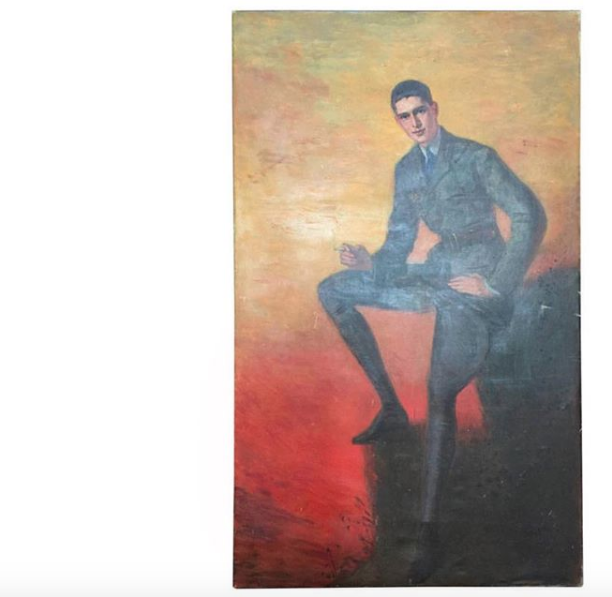
This painting tells the story of Henry Howard Houston Woodward. Born in Chestnut Hill in Philly and educated at Yale. Henry was a charismatic young man who gave his life so that others could be free. Serving first in the Ambulance Corps, Henry's superior officers saw his determination and grit. He was allowed to join the aviators and was soon flying missions. It was on one of those missions that Henry lost his life. His story will always be told though the power of art. I discovered Henry's identity through many late nights in front of my laptop. Even though the painting was signed by the artist Marie Eristoff Kazak, the sitter's identity was not mentioned. His World War I French aviators uniform was my first clue. This eventually led me to a book of his letters published by Yale University press called A Year for France. It was in this book that I found an image of the painting. Henry had written home to his parents and asked if they would wire him the money to have it painted - he wanted there to be a record of him should anything happen. His beautiful letters and this painting tell his remarkable story. This work is now in a Philadelphia area museum. ;-) hkv
Extra Information:
When it is a person. Wait. What? Okay, here’s what I mean. Back in the Summer of 2014 I attended an auction at the warehouse of a once prominent gallery. I was there for the picture frames and I bought about 250 of them. One of the last lots of the auction was a heavy cardboard tube that supposedly contained a rolled up painting. So, being the impulsive gambler and dreamer that I am, I simply kept my hand in the air till the lot was mine. Now I had to hope that there actually was a painting in it. I’ll skip over the excitement of loading a rental truck with 250 frames and then unloading all of them and get right to the good stuff... So, back at my showroom, I carefully removed the canvas from the tube and began to unroll it on my eight foot work table. And I unrolled it. And unrolled it. It was massive. A face was staring at me. A young man in uniform holding a cigarette in his hand staring right at me. Quickly I looked for a signature and found it only after the light caught it just the right way. I first saw a monogram of a crown and then the hyphenated last name Eristoff-Kazak. Fantastic. A signature often makes the research that much easier. Boy, was I in for a surprise. Turns out Eristoff-Kazak was actually Russian Princess Marie Eristoff-Kazak (born Etlinger Mariya Vasilevna later using the names Mary Kazak, Maria Eristova and Marie Eristoff Kazak) a painter of the Russian aristocracy. She was born in Saint Petersburg in 1857 and studied art with the Hungarian born court painter Mihaly Zichy. In 1887, Marie Etlinger married Georgian Prince Dmitry Eristavi. Mr. Zichy brought the Princess to Paris for the first time in 1890, she would later move there permanently in the early 1890’s and become a fixture on the Paris art scene. Her reputation grew and she became known for her portraiture of the Russian aristocracy visiting or living in Paris. The Princess had a long career in Paris, while also sending her work for exhibition to London and St. Petersburg. She died there in 1934. So, now that I’ve learned a bit about the artist I can begin the process of discovering the identity of the sitter. I’d like to digress for a moment and share a similar story about a portrait, a discovery and a story...
Earlier in the year, Colin Gleadell who is an art world reporter for the past 27 years and a regular contributor to many publications including writing a weekly column for The Daily Telegraph’s Art Sales page, reported on a portrait that sold at an auction in the countryside of London. While this would not normally merit inclusion into one of Mr. Gleadell’s columns, this was no ordinary portrait. The artist, Ambrose McEvoy - a London society painter who died in 1927, never really achieved high results in the auction world. Yet this portrait of an unknown woman (which carried a presale estimate of just $1067.) would bring $62,846. Whoa. They say, it just takes two to make a record. Boy were they right. But why all the interest you ask? And just who bought this work? I’ll tell you. Actually Mr. Gleadell coaxed the answers from the buyer, none other than Mr. Philip Mould a London gallery owner specializing in portraits. It seems that Mr. Mould has become quite well known for uncovering the identities of the sitters of the portraits he purchases. And this one was no different. The sitter was a Ms. Lois Sturt a British silent movie star who was born to a Baron in 1900 and died in 1937. Described by her biographer William Cross as a “wild child” and “the brightest of the bright young things”. There’s more to this story and if you want to read it, click here for the full article in The Telegraph. Just make sure to come back here and read why I thought it would be important to tell you about this story...
Now back to the painting in my inventory. Where were we? Oh, right. The Russian Princess artist. Seems she was quite the bohemian artist for being a Princess. Always giving of her work and her time. Living the life of an artist in Paris during the early 20th Century. But just how did she come to paint this portrait. And just who is he. I’ll tell you. Because Mr. Mould is not the only one who can uncover the identity of a sitter in a portrait. Turns out he is none other than Henry Howard Houston Woodward, part of the very prominent Houston Woodward family of Philadelphia (by way of Wilkes-Barre, originally from Connecticut). In 1917, Henry was enrolled at Yale University and set to graduate as part of the Class of 1919. It was during February of that year when Henry volunteered for World War I. He was shipped out to France just two months later. The ship carried him along with hundreds of other volunteers, cargo, trucks, supplies and more. The cross Atlantic journey was slow and Henry was chomping at the bit to arrive in France. Shortly after arrival, Henry’s section of drivers - the Ambulance 13 corps were placed on the front lines in some of WWI’s bloodiest battles. Henry’s bravery, intelligence and determination were quickly recognized and rewarded by his superiors. Henry wanted more responsibility and more action. He had begun training to become a pilot for the French and was quickly excelling in his classes. His hard work was rewarded with extra time off and he received additional days to spend in Paris. And this is where our story takes a turn.
It was in Paris where Russian Baron Eugene Fersen was escaping the aftermath of the Bolshevik Revolution serving as the head of a Russian Mission. The Baron, born in St. Petersburg in 1873, was the eldest son of a Grand Duchess who was a mistress to (it is reported) Czar Nicholas II (you know, the Bloody Czar...). He was quietly living in Paris and working on his manifesto which would later become the Light Bearers Society and the Science of Being (the Baron and his mother later moved to the United States, bought a gilded age mansion in Seattle owned by an imprisoned con man and used that as the headquarters for their society until his death in 1954). But, I’m getting ahead of myself. Back to Paris. The Baron was close friends with the Princess and offered a few rooms in his apartment for her to use as a painting studio. It was around this time that the Baron met Henry. The exact details of their first encounter are not known, but we do know that the two shared a very close and personal relationship. The Baron was quick to recognize Henry’s first rate character and Henry was enamored by the tales the Baron would tell of his family, his life in Russia and all that the Baron promised him after the war. The two spent as much time together as the war would allow. And it was on one of those weekends together when Henry met the Princess. She, too, recognized something special in Henry and asked if he’d like to have his portrait painted. She saw in him “an Egyptian face, ancient Egypt, that is, not modern”. The Princess painted Henry with “a classic mouth, long, straight nose, high cheek bones, and long sphinx eyes!”. And Henry knew that the Princess was “really a genius” and was “about the best portrait painter in Europe now, and in France for certain”. You could say that the two really hit it off. Henry had asked his family back home in Philadelphia for the 5000 Francs (about $1000 at the time) to pay for the portrait and said that “it would be a good souvenir in case anything did happen to me.”
Sadly Henry’s words would be prophetic. Just two weeks after having his portrait painted1918, Henry’s plane would be shot down over the small town of Montdidier, France. It was not until 1919 that the plane would be discovered. Henry’s family travelled to Montdidier sometime in 1920 to erect a monument to their son, help to rebuild a cathedral in the town that had been damaged in the war and to collect his personal belongings. This painting was among them. Once the belongings arrived back in the States, the painting was to remain rolled up. Forgotten. If not for that auction, Henry’s story would also have been forgotten. Now it will live on forever thanks to the Power of Art. Oh, and some detective work.